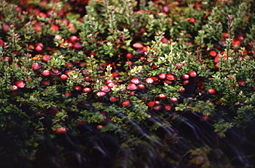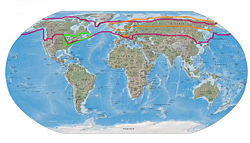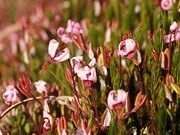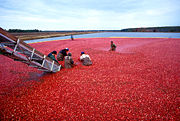Cranberry
| Cranberry | ||||||||||||||
|---|---|---|---|---|---|---|---|---|---|---|---|---|---|---|
 Cranberry bush with fruit partially submerged
|
||||||||||||||
| Scientific classification | ||||||||||||||
|
||||||||||||||
| Species | ||||||||||||||
|
Vaccinium erythrocarpum |

Cranberries are a group of evergreen dwarf shrubs or trailing vines in the genus Vaccinium subgenus Oxycoccos, or in some treatments, in the distinct genus Oxycoccos. They are found in acidic bogs throughout the cooler parts of the Northern Hemisphere.
Cranberries are low, creeping shrubs or vines up to 2 m long and 5 to 20 cm in height;[1] they have slender, wiry stems that are not thickly woody and have small evergreen leaves. The flowers are dark pink, with very distinct reflexed petals, leaving the style and stamens fully exposed and pointing forward. They are pollinated by domestic honey bees. The fruit is an epigynous berry that is larger than the leaves of the plant; it is initially white, but turns a deep red when fully ripe. It is edible, with an acidic taste that can overwhelm its sweetness.
Cranberries are a major commercial crop in certain American states and Canadian provinces (see "Cultivation and Uses" below). Most cranberries are processed into products such as juice, sauce, and sweetened dried cranberries, with the remainder sold fresh to consumers. Cranberry sauce is regarded an indispensable part of traditional American and Canadian Thanksgiving menus and European winter festivals.
Since the early 21st century within the global functional food industry, there has been a rapidly growing recognition of cranberries for their consumer product popularity, nutrient content and antioxidant qualities, giving them commercial status as a novel "superfruit".[2][3]
Contents |
Species and description
There are three to four species of cranberry, classified in two sections:
- Subgenus Oxycoccos, sect. Oxycoccos
- Vaccinium oxycoccos or Oxycoccos palustris (Common Cranberry or Northern Cranberry) is widespread throughout the cool temperate Northern Hemisphere, including northern Europe, northern Asia and northern North America. It has small 5-10 mm leaves. The flowers are dark pink, with a purple central spike, produced on finely hairy stems. The fruit is a small pale pink berry, with a refreshing sharp acidic flavour.
- Vaccinium microcarpum or Oxycoccos microcarpus (Small Cranberry) occurs in northern Europe and northern Asia, and differs from V. oxycoccus in the leaves being more triangular, and the flower stems hairless. Some botanists include it within V. oxycoccos.
- Vaccinium macrocarpon or Oxycoccos macrocarpus (Large cranberry, American Cranberry, Bearberry) native to northeastern North America (eastern Canada, and eastern United States, south to North Carolina at high altitudes). It differs from V. oxycoccus in the leaves being larger, 10-20 mm long, and in its slightly apple-like taste.
- Subgenus Oxycoccos, sect. Oxycoccoides
- Vaccinium erythrocarpum or Oxycoccos erythrocarpus (Southern Mountain Cranberry) native to southeastern North America at high altitudes in the southern Appalachian Mountains, and also in eastern Asia.

Cranberries are related to bilberries, blueberries, and huckleberries, all in Vaccinium subgenus Vaccinium. These differ in having stouter, woodier stems forming taller shrubs, and in the bell-shaped flowers, the petals not being reflexed.
Some plants of the completely unrelated genus Viburnum are sometimes inaccurately called "highbush cranberries" (Viburnum trilobum).
Cranberries are susceptible to false blossom, a harmful but controllable phytoplasma disease common in the eastern production areas of Massachusetts and New Jersey.
Etymology and history

The name cranberry derives from "craneberry", first named by early European settlers in America who felt the expanding flower, stem, calyx, and petals resembled the neck, head, and bill of a crane (bird). Another name used in northeastern Canada is mossberry. The traditional English name for Vaccinium oxycoccos, fenberry, originated from plants found growing in fen (marsh) lands.
Cranberries are a very popular fruit for wild harvesting in the Nordic countries and Russia . In Scotland, the berries were originally wild-harvested but with the loss of suitable habitat, the plants have become so scarce that this is no longer done. In North America, Native Americans were the first to use cranberries as food. Calling the red berries Sassamanash, natives may have introduced cranberries to starving English settlers in Massachusetts who incorporated the berries into traditional Thanksgiving feasts. American Revolutionary War veteran Henry Hall is credited as first to farm cranberries in the Cape Cod town of Dennis around 1816.
Cultivation and uses
Geography and bog method

Cranberries are a major commercial crop in the U.S. states of Maine, Massachusetts, Michigan, Minnesota, New Jersey, Oregon, Washington, and Wisconsin, as well as in the Canadian provinces of British Columbia, New Brunswick, Ontario, Nova Scotia, Newfoundland and Quebec. According to the Economic Research Service of the United States Department of Agriculture, Wisconsin is the leading producer of cranberries, with over half of U.S. production. Massachusetts is the second largest U.S. producer, with 28% of total domestic production. A very small production is found in southern Chile, in the Baltic States, and in Eastern Europe.
Historically, cranberry beds were constructed in wetlands. Currently cranberry beds are constructed in upland areas that have a shallow water table. The topsoil is scraped off to form dikes around the bed perimeter. Clean sand is hauled in to a depth of four to eight inches. The surface is laser leveled with a slight crown in the center to facilitate drainage. Beds are frequently drained with socked tile in addition to the perimeter ditch. In addition to making it possible to hold water, the dikes allow equipment to service the beds without driving on the vines. Irrigation equipment is installed in the bed to provide irrigation for vine growth and for spring and autumn frost protection.
Cultivation
Cranberry vines are propagated by moving vines from an established bed. The vines are spread on the surface of the sand of the new bed and pushed into the sand with a blunt disk. The vines are watered frequently during the first few weeks until roots form and new shoots grow. Beds are given frequent light application of nitrogen fertilizer during the first year. The cost of establishment for new cranberry beds is estimated to be about US$70,000 per hectare.
A common misconception about cranberry production is that the beds remain flooded throughout the year. During the growing season cranberry beds are not flooded, but are irrigated regularly to maintain soil moisture. Beds are flooded in the autumn to facilitate harvest and again during the winter to protect against low temperatures. In cold climates like Wisconsin, Massachusetts, and eastern Canada the winter flood typically freezes into ice, while in warmer climates the water remains liquid. When ice forms on the beds, trucks can be driven onto the ice to spread a thin layer of sand that helps to control pests and rejuvenate the vines. Sanding is done every three to five years.
Harvesting and food uses
Cranberries are harvested in the all when the fruit takes on its distinctive deep red color. This is usually in late September or early October. To harvest cranberries, the beds are flooded with six to eight inches of water above the vines. A harvester is driven through the beds to remove the fruit from the vines. For the past 50 years, water reel type harvesters have been used. Harvested cranberries float in the water and can be corralled into a corner of the bed and conveyed or pumped from the bed. From the farm, cranberries are taken to receiving stations where they are cleaned, sorted, and stored prior to packaging or processing.
Although most cranberries are wet-picked as described above, 5-10% of the US crop is still dry-picked. This entails higher labor costs and lower yield, but dry-picked berries are less bruised and can be sold as fresh fruit instead of having to be immediately frozen or processed. Originally performed with two-handed comb scoops, dry picking is today accomplished by motorized, walk-behind harvesters which must be small enough to traverse beds without damaging the vines.
White cranberry juice drinks are made from regular cranberries that have been harvested after the fruits are mature, but before they have attained their characteristic dark red color. Yields are lower on beds harvested early and the early flooding tends to damage vines, but not severely.
About 95% of cranberries are processed into products such as juice drinks, sauce, and sweetened dried cranberries. The remaining 5% is sold fresh to consumers. Cranberries destined for processing are usually frozen in bulk containers shortly after arriving at a receiving station. To allow air movement deterring decay, cranberries for fresh market are stored in shallow bins or boxes with perforated or slatted bottoms. Because harvest occurs in late autumn, cranberries for fresh market are frequently stored in thick walled barns without mechanical refrigeration. Temperatures are regulated by opening and closing vents in the barn as needed.
Usually cranberries as fruit are served as a compote or jelly, often known generically as cranberry sauce. Such preparations are traditionally served with roast turkey meat and are considered by some to be a staple of English Christmas dinners, and the Canadian and US holiday Thanksgiving. The berry is also used in baking (muffins, scones and cakes) but, unlike many other berries, is normally considered too sharp to be eaten unaccompanied.
Fresh cranberries can be frozen at home, and will keep up to nine months; they can be used directly in recipes without thawing.[4]
Cranberry juice is a major use of cranberries; it is usually either sweetened to reduce its natural severe tartness and make "cranberry juice cocktail" or blended with other fruit juices.
Nutrients and antioxidant capacity
Cranberries have moderate levels of vitamin C, dietary fiber and the essential dietary mineral, manganese, as well as a balanced profile of other essential micronutrients.[5]
By measure of the Oxygen Radical Absorbance Capacity with an ORAC score of 9,584 units per 100 g, cranberry ranks near the top of 277 commonly consumed foods in the United States.[6]
| Nutrients in raw cranberries[7] | ||
| Nutrient | Value per 100 grams | % Daily Value |
|---|---|---|
| Energy | 46 kcal | |
| Fiber, total dietary | 4.6 g | 15.3% |
| Sugars, total | 4.04 g | |
| Calcium, Ca | 8 mg | 0.8% |
| Magnesium, Mg | 6 mg | 1.9% |
| Manganese, Mn | 0.15 mg | 7% |
| Phosphorus, P | 13 mg | 1.9% |
| Potassium, K | 85 mg | 1.8% |
| Sodium, Na | 2 mg | 0.1% |
| Vitamin C, total ascorbic acid | 13.3 mg | 16% |
| Vitamin A, IU | 60 IU | 9% |
| Vitamin K, mcg | 5.1 mcg | 6.4% |
| Carotene, beta | 36 mcg | ne |
| Lutein + zeaxanthin | 91 mcg | ne |
ne: Daily Value not established
Health benefits and potential health benefits
Phytochemicals
Cranberries are a source of polyphenol antioxidants, phytochemicals under active research for possible benefits to the cardiovascular system, immune system and as anti-cancer agents.[8][9]
Cranberry juice contains a chemical component, a high molecular weight non-dializable material (NDM), as noted above, that is able to inhibit and even reverse the formation of plaque by Streptococcus mutans pathogens that cause tooth decay.[10][11] Cranberry juice components also show efficacy against formation of kidney stones.[12][13]
Raw cranberries and cranberry juice are abundant food sources of the anthocyanidin flavonoids, cyanidin, peonidin and quercetin.[14][15] These compounds have an unknown effect on human health, but are powerful against human cancer cells in vitro. Their effect in humans, however, is unproven, showing poor absorption into human cells and rapid elimination from blood.
Since 2002, there has been an increasing focus on the potential role of cranberry polyphenolic constituents in preventing several types of cancer.[16][17][18][19][20] In a 2001 University of Maine study that compared cranberries with twenty other fruits, cranberries had the largest amount of both free and total phenols, with red grapes at a distant second place.[21] Cranberry tannins have anti-clotting properties and may reduce urinary tract infections and the amount of dental plaque-causing oral bacteria, thus being a prophylaxis for gingivitis.[22]
Anti-adhesion properties
There is potential benefit of cranberry juice consumption against bacterial infections in the urinary system. Research shows that an effect occurs from a component of the juice inhibiting bacterial attachment to the bladder and urethra.[23] [24] [25]
Although promising for anti-bacterial activity, long-term consumption of cranberry juice has only limited evidence for beneficial effects against urinary tract infections in women.[26] Similar applications have not been successfully proved in other clinical trials of consuming cranberry juice or tablets by people with spinal cord injury associated with bladder catheterization, neurogenic bladder or infrequent urination, any of which may be associated with increased susceptibility to bacterial infections.[27][28][29]
Current and completed clinical trials
In April 2004, the French government agency AFSSA, which regulates food products in a way similar to the United States FDA, granted approval of cranberry juice as an antibacterial agent for urinary tract health.[30]
To date, four completed randomized clinical trials have shown evidence for inhibiting bacterial infections in the urinary tract of women by drinking cranberry juice over a 12 month period.[31]
The US National Center for Complementary and Alternative Medicine (NCCAM) also reports three recently completed and four ongoing clinical trials of cranberry juice or capsules (pharmacy).[32] Six of these human studies are examining antibacterial effects in female urinary tract infections. One evaluates effects of cranberry polyphenols on cytochrome P450 enzymes involved in metabolism. To evaluate the drug interaction potential of cranberry, alprazolam, dextromethorphan and caffeine are being examined. As of January 2008, the results of these trials have not been published.
Possible contraindications
An autumn 2004 caution from the Committee on Safety of Medicines, the UK agency dealing with drug safety, advised patients taking warfarin not to drink cranberry juice after adverse effects (such as increased incidence of bruising) were reported, possibly resulting from the presence of salicylic acid native to polyphenol-rich plants such as the cranberry. However, during 2006-8, several reviews of case reports and pilot studies have failed to confirm this effect, collectively indicating no statistically significant interaction between daily consumption of 250 mL cranberry juice and warfarin in the general population.[33][34]
Marketing and economics
History
Cranberry sales have traditionally been associated with the United States holidays of Thanksgiving and Christmas. Until the 1930s most of the crop was sold fresh.
Cranberry growers have a long history of cooperative marketing. As early as 1904, John Gaynor, a Wisconsin grower, and A.U. Chaney, a fruit broker from Des Moines, Iowa, organized Wisconsin growers into a cooperative called the Wisconsin Cranberry Sales Company to receive a uniform price from buyers. Growers in New Jersey and Massachusetts were also organized into cooperatives, creating the National Fruit Exchange that marketed fruit under the Eatmor brand. The success of cooperative marketing almost led to its failure. With consistent and high prices, area and production doubled between 1903 and 1917 and prices fell. In 1918, US$54,000 was spent on advertising, leading to US$1 million in increased sales.
With surplus cranberries and changing American households some enterprising growers began canning cranberries that were below-grade for fresh market. Competition between canners was fierce because profits were thin. The Ocean Spray cooperative was established in 1930 through a merger of three primary processing companies: Ocean Spray Preserving company, Makepeace Preserving Co, and Cranberry Products Co. The new company was called Cranberry Canners, Inc. and used the Ocean Spray label on their products. Since the new company represented over 90% of the market, it would have been illegal (cf. antitrust) had attorney John Quarles not found an exemption for agricultural cooperatives. As of 2006, about 65% of the North American industry belongs to the Ocean Spray cooperative. (The percentage may be slightly higher in Canada than in the U.S.)
A turning point for the industry occurred on November 9, 1959 when the secretary of the United States Department of Health, Education, and Welfare Arthur S. Flemming announced that some of the 1959 crop was tainted with traces of the herbicide aminotriazole. The market for cranberries collapsed and growers lost millions of dollars.[35] However, the scare taught the industry that they could not be completely dependent on the holiday market for their products: they had to find year round markets for their fruit. They also had to be exceedingly careful about their use of pesticides.
After the aminotriazole scare, Ocean Spray reorganized and spent substantial sums on product development. New products such as cranberry apple juice blends were introduced, followed by other juice blends.
A Federal Marketing Order that is authorized to synchronize supply and demand was approved in 1962. The order has been renewed and modified slightly in subsequent years, but it has allowed for more stable marketing. The market order has been invoked during six crop years: 1962 (12%), 1963 (5%), 1970 (10%), 1971 (12%), 2000 (15%), and 2001 (35%). Even though supply still slightly exceeds demand, there is little will to invoke the Federal Marketing Order out of the realization that any pullback in supply by U.S. growers would easily be filled by Canadian production.
Prices and production increased steadily during the 1980s and 1990s. Prices peaked at about $65.00 per barrel (A cranberry barrel = 100 pounds or 45.4 kg) in 1996 then fell to $18.00 per barrel in 2001. The cause for the preciptous drop was classic oversupply. Production had outpaced consumption leading to substantial inventory in freezers or as concentrate.
Cranberry handlers (processors) include Ocean Spray, Cliffstar, Inc., Northland Cranberries, Clement Pappas & Co., Decas Cranberry Products as well as a number of small handlers and processors.[36]
See also
- Naturopathic medicine
- Nutrition
References
- ↑ Cranberry Institute: About Cranberries
- ↑ HortResearch - Newsroom - 'Superfruits' the future of health
- ↑ Superfruit To the Rescue > General News | New Zealand News UK | nznewsuk.co.uk
- ↑ The American Cranberry-Basic Information on Cranberries
- ↑ [1] Cranberry in-depth nutrient analysis, World's Healthiest Foods
- ↑ [2] Oxygen Radical Absorbance Capacity of Selected Foods - 2007; Nutrient Data Laboratory, Agricultural Research Service, United States Department of Agriculture, November 2007
- ↑ U.S. Department of Agriculture: Nutrient Data Laboratory -- USDA Nutrient Database A searchable index of food nutrient composition. Search on cranberries for raw cranberry nutrient composition. Search on cranberry for other cranberry products.
- ↑ A review of the interaction among dietary antioxid...[J Nutr Biochem. 2007] - PubMed Result
- ↑ Dietary polyphenols: good, bad, or indifferent for...[Cardiovasc Res. 2007] - PubMed Result
- ↑ The Cranberry Institute
- ↑ Blocking tooth decay
- ↑ Influence of cranberry juice on the urinary risk f...[BJU Int. 2003] - PubMed Result
- ↑ Effect of blackcurrant-, cranberry- and plum juice...[Eur J Clin Nutr. 2002] - PubMed Result
- ↑ [3] Duthie SJ, Jenkinson AM, Crozier A, Mullen W, Pirie L, Kyle J, Yap LS, Christen P, Duthie GG. The effects of cranberry juice consumption on antioxidant status and biomarkers relating to heart disease and cancer in healthy human volunteers. Eur J Nutr. 2006 Mar;45(2):113-22.
- ↑ Zheng W, Wang SY. Oxygen radical absorbing capacity of phenolics in blueberries, cranberries, chokeberries, and lingonberries. J Agric Food Chem. 2003 Jan 15;51(2):502-9.[4]
- ↑ Cancer Research Society Newsletter : The Cranberry – A Natural and Delicious Antidote
- ↑ Cranberry and blueberry: evidence for protective e...[Mol Nutr Food Res. 2007] - PubMed Result
- ↑ In vivo inhibition of growth of human tumor lines ...[Nutr Cancer. 2006] - PubMed Result
- ↑ Blackberry, black raspberry, blueberry, cranberry,...[J Agric Food Chem. 2006] - PubMed Result
- ↑ Antioxidant and antiproliferative activities of co...[J Agric Food Chem. 2002] - PubMed Result
- ↑ November, 2001. Cranberry Research Findings: Journal of Agriculture and Food Chemistry, University of Maine, Vol. 49, No. 11.
- ↑ http://www.umaine.edu/umext/cranberries/Health%20Benefits%20-%20Keep%20Doctor%20&%20Dentist%20Away.htm University of Maine
- ↑ http://www.eurekalert.org/pub_releases/2008-07/wpi-cjc072108.php
- ↑ http://www.physorg.com/news77194887.html
- ↑ http://www.sciencedaily.com/releases/2008/07/080721152005.htm
- ↑ Cranberries for preventing urinary tract infection...[Cochrane Database Syst Rev. 2004] - PubMed Result
- ↑ Evaluation of cranberry supplement for reduction o...[J Spinal Cord Med. 2004] - PubMed Result
- ↑ Effect of cranberry extract on bacteriuria and pyu...[J Spinal Cord Med. 2004] - PubMed Result
- ↑ Spinal-injured neuropathic bladder antisepsis (SIN...[Spinal Cord. 2007] - PubMed Result
- ↑ [5] Cranberry health claims to boost sales in France, FoodNavigator.com-Europe, July 2004
- ↑ [6] Jepson RG, Craig JC. A systematic review of the evidence for cranberries and blueberries in UTI prevention. Mol Nutr Food Res. 2007 Jun;51(6):738-45.
- ↑ [http://clinicaltrials.gov/search/term=(NCCAM)+%5BSPONSOR%5D+(cranberry)+%5BTREATMENT%5D?recruiting=false Clinicaltrials.gov, January 2008]
- ↑ [7] Li Z, Seeram NP, Carpenter CL, Thames G, Minutti C, Bowerman S. Cranberry does not affect prothrombin time in male subjects on warfarin. J Am Diet Assoc. 2006 Dec;106(12):2057-61.
- ↑ [8] Pham DQ, Pham AQ. Interaction potential between cranberry juice and warfarin. Am J Health Syst Pharm. 2007 Mar 1;64(5):490-4.
- ↑ "Cranberry Blues" 1959 recording (mp3 file) by Robert Williams and the Groovers
- ↑ http://www.pubhort.org/hr/hr21/HR_21_07_00000000.pdf
External links
- The Wisconsin State Cranberry Growers Association general information about the WI cranberry industry
- Germplasm Resources Information Network: Sect. Oxycoccus and Sect. Oxycoccoides
- Cape Cod Cranberry Growers' Association for information on cranberry culture
- University of Massachusetts Amherst Cranberry Station for information on cranberry research
- Cranberry Library Page Hosted by the University of Wisconsin-Madison
- Wikimapia An overhead view of a cranberry farm near Wisconsin Rapids, Wisconsin
- Cranberry research at Rutgers, The State University of New Jersey